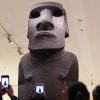ART NEWS
How the Covid Art Museum conveys the emotive consequences of the pandemic
Even as COVID-19 continues to wreak havoc, artists are finding creative ways to express the myriad moods associated with the pandemic and lockdowns.The Covid Art Museum (CAM), perhaps the first of its kind in the world, features art conveying hope, anxiety, courage, fear, boredom, struggle, solidarity, loneliness, and, even the feeling of ‘languishing.’ Created by Emma Calvo, José Guerrero and Irene Llorca, three friends, advertising executives and art enthusiasts in Barcelona, Spain, the digital museum, launched on March 19, 2020 features art from all over the world. Centred on the pandemic, it includes photographs, animation, installations, illustrations, graphic art and cartoons. Common elements such as masks, sanitisers, gloves, methods of social distancing and, of course, the Coronavirus itself, can be found in many of the pieces. Edited excerpts from an e-mail interview with José Guerrero: Why did you create this digital museum?We created the museum because we were locked up at home like everyone else, in Spain. It was a strange and worrying situation, but people were doing amazing things such as concerts on balconies, yoga classes on rooftops and streaming choreographies. One of these activities was also art that talked about the pandemic. We noticed this trend and thought it would be a good idea to bring all these works together in one museum so they wouldn’t fall into oblivion. That’s how we created The CAM on Instagram from the sofa of our homes.How many works are there now? There are more than 840 publications at the time of this interview. Every day we upload new works. They come from all over the world — from Brazil, USA and Spain to India, Indonesia and Russia.How are the artworks selected? The main criteria is that they should be related to the current moment: the crisis of COVID-19. That’s why we don’t close ourselves to any technique. We collect all kinds of art whether they are illustrations, photographs, paintings, poems, drawings, animations, videos…. From all the works received or found, a selection of those that best reflect the pandemic situation, is published. Quality and originality are also important to us. Even if it is digital right now, we are still a museum. We want to keep the standards of a museum you would physically visit.Do you have any particularly favourite ones?It is very difficult to choose our favourite artworks because we discover new ones every day, so they change. The ones we tend to like the most are the ones that bring a different point of view that no one had thought of before about the pandemic. Or the ones that express a feeling we have all felt, but in an original way. Has anyone from India been featured?There are several published works that have come from India and they are very interesting projects. They bring their particular vision of the situation, because despite the similarities, each part of the world has experienced the pandemic in a different way.How do you think art has helped people cope with social isolation?The Internet connects people from all over the world regardless of distance, and that is very useful in the context of crisis, pandemic and quarantine. Being stuck at home, under such circumstances, one can feel depressed, worried and very lonely. That’s why we thought it was a good idea to create a museum that would show what was happening at the time. Then, the public would could feel less lonely and see that millions of people were living and feeling the same thing. In times of crisis, it is essential to feel accompanied. With the museum, people felt integrated into a community where they could participate and contribute their own works or simply write their thoughts in the comments section or share their artworks.Once the pandemic is over, what are your plans? We will continue to publish COVID-related artworks in the museum for as long as artists keep sending them. When that ends, the museum will always be open so people can remember what the pandemic was, how people experienced it, and what they felt.











